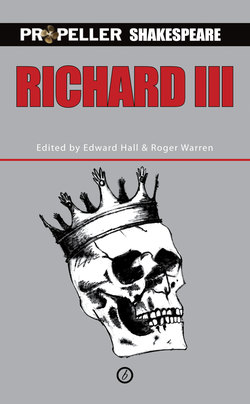Читать книгу Richard III - William Shakespeare - Страница 12
На сайте Литреса книга снята с продажи.
ОглавлениеMusic in Richard III
Propeller’s music is either written by the company or sourced from music we know. We play or sing our suggestions to Edward Hall, and he decides what goes into the production, and at what point in the play. Having adapted Rose Rage from the Henry VI plays, Edward wanted Richard III to have a similar soundscape – English choral music, especially madrigals and church music – and, as I used to sing in a cathedral choir, I ended up arranging and co-ordinating most of the music.
I wanted to give Richard III the feeling of a Requiem Mass. The Dies Irae, a thirteenth-century Latin poem about Judgement Day, used to be recited at Catholic funerals, and we sing arrangements of the original plainsong tune to underscore executions and curses – ‘A day of wrath that day will be, when the age will dissolve into dust.’ We are also using the final words of the poem, Pie Jesu, to book-end the production – ‘Blessed Lord Jesus, grant them eternal rest.’
Most of our music for Richard III has been chosen because the lyrics seem appropriate to the play, but I have also tried to focus on two musical themes: descending scales and semi-tone intervals.
Edward initially said to me that this production might track Richard’s descent into hell, so descending scales were an obvious choice: Down among the dead men, an eighteenth-century British folk tune and our theme for the murderers, repeats the word ‘Down’ as the pitch descends; Locus Iste, a nineteenth-century motet by Bruckner, underscores various scene changes in the first half and has an eerie bass line which descends chromatically (Irreprehensibilis est); our modern arrangement of Dies Irae at Buckingham’s death uses the same downward chromatic scale but with higher voices.
Chromaticism and the juxtaposition of semi-tone intervals (i.e. notes that are very close in pitch) are central to modern harmony. My brother and I were both choir boys, and we used to play out our sibling rivalry by one of us singing a note, and the other singing the semi-tone next to it: the resultant discord forced one of us to change note. I wanted to use the same modern, semi-tone discords to reflect the rivalry of Richard and Richmond for the crown.
For Richmond ‘the Welshman’, we use a traditional Welsh hymn tune (Judge Eternal, throned in splendour, Rhuddlan), complete with nineteenth-century lyrics about ‘purging the realm’ and ‘cleansing the nation’ – disturbing words to us in the modern era. Hopefully, in my harmony arrangement the semi-tones clashing and resolving enhance this ambiguity in Richmond’s character – morally disturbing, yet beautifully persuasive. The older songs we sing too, Now is the Month of Maying (a fifteenth-century madrigal by Thomas Morley) and the Coventry Carol (from a sixteenth-century mystery play depicting King Herod’s massacre of innocent children) both oscillate between major and minor keys, hinging around a semi-tone difference in harmony, with the result that the listener feels either delightfully surprised or deeply unsettled.
Jon Trenchard
